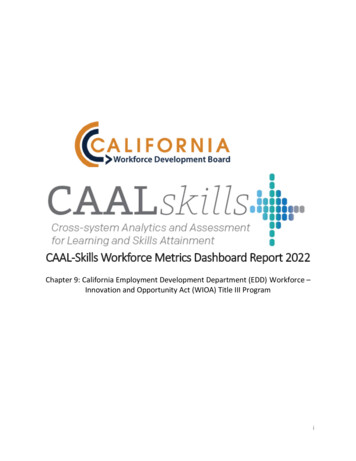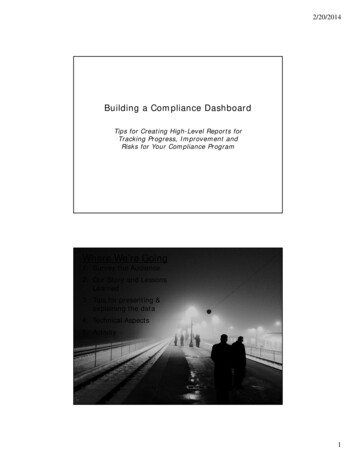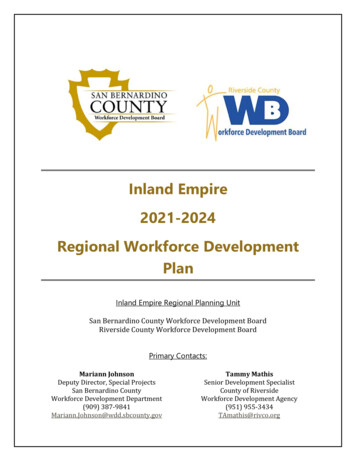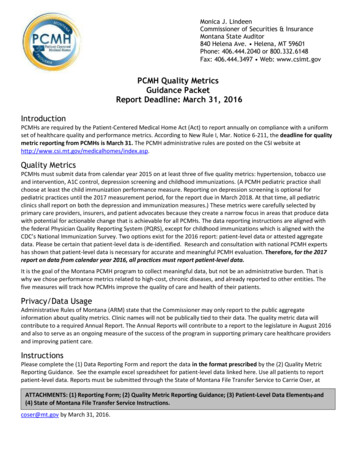
Transcription
CAAL-Skills Workforce Metrics Dashboard Report 2022Chapter 9: California Employment Development Department (EDD) Workforce –Innovation and Opportunity Act (WIOA) Title III Programi
The California Workforce Development Board (CWDB) assists the Governor in setting and guiding policy in the areaof workforce development. The CWDB is responsible for assisting the Governor in performing the duties andresponsibilities required by the federal Workforce Innovation and Opportunity Act (WIOA) of 2014.California’s Unified Strategic Workforce Development Plan directs its work in providing guidance to the statewideworkforce development system.The production of this report would not have been possible without the ongoing support and participation of theCAAL-Skills partner agencies and the diligent work of the Employment Development Department (EDD) LaborMarket Information Division.This document can be found on the CWDB’s website at cwdb.ca.govCalifornia Workforce Development Board800 Capitol Mall, Suite 1022Sacramento, CA 95814T: 916-657-1440F: 916-657-1377ii
Table of Contents9California Employment Development Department (EDD) – Workforce Innovationand Opportunity Act (WIOA) Title III Program.19.1Participant Ethnicity .79.1.1 Participant Ethnicity .79.2Participant Race . 149.2.1 Participant Race . 149.3Participant Sex / Gender . 229.3.1 Participant Sex/Gender . 229.4Participant Age Group at Entry . 299.4.1 Participant Age Group at Entry . 299.5Participant Veteran Status . 369.5.1 Participant Veteran Status . 369.6Industry / Sector of Employment . 449.6.1 Industry/Sector of Employment . 449.7Quarterly Earnings . 539.7.1 Quarterly Earnings . 539.8Program Performance . 569.8.1 Program Performance . 56iii
9California Employment Development Department (EDD) –Workforce Innovation and Opportunity Act (WIOA) Title IIIProgramProgram Overview - The Wagner-Peyser Act of 1933 provides for establishment of anationwide system of public employment offices. Services provided include job searchassistance, job referrals, and placement assistance to jobseekers, reemployment services tounemployment insurance recipients; and assistance in identifying candidates for job openingsto employers.Until 1998, Wagner-Peyser offices were standalone facilities offering these services tojobseekers. Subsequent workforce legislation in the 1960s, 1970s, and 1980s introduced newtypes of services and programs related to workforce preparation and employment (e.g.,programs for youth, job-training programs, and direct public service employment) but left theWagner-Peyser centers’ role largely unchanged. However, the advent of the 1998 WorkforceInvestment Act (WIA) introduced a new focus on both labor market attachment services andcreating unified, walk-in, job-center “one-stop” facilities (America’s Job Centers of California, orAJCCs) where such services could be accessed. Aware that separate Wagner-Peyser officesproviding similar services already existed, the framers of the 1998 legislation included WagnerPeyser services as a required partner in the new one-stop service delivery model.1 However, thelaw stopped short of prohibiting the continued existence of separate, stand-alone WagnerPeyser offices. The Workforce Innovation and Opportunity Act (WIOA) of 2014 continues WIA’sfocus on one-stop service access and the efficient use of resources, and entrenches the onestop delivery model by requiring every Local Workforce Development Area (Local Area) to hostat least one comprehensive AJCC—a job center at which all partner services including WagnerPeyser are present. In addition, a clause (Section 121[e][3]) of the current law specificallyrequires that Wagner-Peyser services be co-located at AJCCs to improve service delivery andavoid duplication of effort. In California, the vast majority of Wagner-Peyser offices werealready located within AJCCs by the time WIOA went into effect in July 2015. 2 With WIOA, thefew remaining stand-alone Wagner-Peyser offices moved into their neighboring AJCC locations.In California, the Wagner-Peyser program is administered by the Employment DevelopmentDepartment (EDD), and provides job services to 1.5 million people annually.3 This figureincludes all individuals who accessed services under WIOA Title III Wagner-Peyser includingthose who used self-services online or at an AJCC. Data in the report do not count individualswhose only contact with Title III services was via self-service activities (e.g., accessing job search1Workforce Investment Act (1998), Section 121.In California, EDD records indicate that only eight stand-alone Wagner-Peyser offices still existed at the timeWIOA went into effect in 2015.3 CWDB Unified Strategic Workforce Development Plan for 2020-2023.21
via CalJOBS, or using an AJCC resource room) as “participants”. To be included in program datain this report, a participant must have received at least one staff-assisted service.Eligibility for Wagner-Peyser services extends to any individual with a legal right to work. Thismakes the pool of WP participants large, broad, and diverse.Program and service delivery structureAJCCs offer a variety of services that bring employers with job openings and qualified jobseekers together. Customers may access services through self-service or with the assistance ofstaff. Through AJCCs, the Wagner-Peyser program provides job-seekers with: Job search training workshops to acquire the skills needed to find and keep a job Referral to partner agencies that provide other employment-related services, includingtraining.4Additionally, through the online labor exchange system, CalJOBSSM, the EDD offers a statewidenetwork that links employers with qualified job seekers throughout California.Some clarification of terminology and program design is needed here: “Wagner-Peyser” is thename of the original 1933 legislation that created a national system of public employmentoffices.5 Subsequent workforce legislation re-authorized the original Wagner-Peyser Act, andmade amendments to it. Programmatically speaking, up until WIOA’s 2014 passage, allworkforce system participants were also inherently considered to be “Wagner-Peyserparticipants”.Title III is the title of the WIOA legislation dealing with re-authorization of and amendments tothe Wagner-Peyser legislation.This can be confusing—since “Wagner-Peyser services” are ultimately characterized by virtue ofthe program that employs the staff who provide them, and not necessarily by a difference incharacteristics of an individual service itself. To illustrate: both Wagner-Peyser and the Adultprogram under Title I provide participants with different types of “basic” career services, whichmay (in both programs) include job search assistance or use of an online job search tool.In part to streamline the overlap created by the multiple acts of legislation, in California,jobseekers who enter an AJCC and access self-services can be initially registered under ashortened version of an application, known as Registered Individual eligibility. RegisteredIndividual eligibility enables Title I and Title III staff to track participants engaged in self-serviceactivities so they don’t have to complete a full program application. Data collected under theRegistered Individual eligibility application is included in this chapter, if participantssubsequently received staff-assisted services.Subsequently, if individuals are referred on to more services, a formal Title III (or other Title)application will be completed for them. Types of applications under Title III include the45Employment Development Department. “Wagner-Peyser Act”.See: U.S. Department of Labor – “Wagner-Peyser Act of June 6, 1933”2
following: Wagner-Peyser, Jobs for Veterans state grant (JVSG), or Migrant and SeasonalFarmworker (MSFW) program.In the present chapter’s data, data contain both participants who were enrolled under theReportable Individual registration, as well as those enrolled under the Wagner-Peyser, JVSG,and MSFW applications (see next section for a discussion of eligibility).However, in order to capture a definition of “participant” that is on par with other programs inthis report, individuals whose only interaction with Title III services was through self-service arenot counted as participants in data for this report.EligibilityEligibility for Title III services is universal, with services made available to any jobseeker,regardless of employment status. Veterans receive priority, and disabled veterans receive thehighest priority. Reemployment services are available to UI recipients.Additionally, services are provided under Title III (and captured in this report’s data) toindividuals who meet the definition of being a migrant or seasonal farmworker. Seasonalfarmworkers are individuals who are employed (or were in the previous year) in farm work of aseasonal or other temporary nature. Labor is performed on a seasonal basis where, ordinarily,the employment pertains to, or is of the kind exclusively performed at certain seasons, orperiods of the year and which, from its nature, may not be continuous or carried on throughoutthe year. A worker, who moves from one seasonal activity to another, while employed in farmwork, is employed on a seasonal basis even though he/she may continue to be employedduring a major portion of the year. A migrant farmworker is a seasonal farmworker (as definedabove) who travels to the job site so that the farmworker is not reasonably able to return tohis/her permanent residence within the same day.Clearly, the non-year-round nature of seasonal and migrant farmworkers’ employment posesspecific challenges for these workers—in that they usually cannot depend on steady paythroughout the calendar year, while income of such workers even during the parts of the yearwhen they are working full-time is likely to be low.6 In California, this population is also likely tohave substantial overlap with other barrier-facing populations such as English language learnersand therefore may have specific workforce service requirements. Finally, many in this6Data from the EDD-LMID finds that MSFWs are typically employed as crop workers. Under the North AmericanIndustry Classification System (NAICS), crop production jobs are counted in two industries: crop production andfarm labor contractors and crew leaders. Whereas crop production jobs are mostly field-based and reporteddirectly by growers, farm labor contractors supply workers to farms and a job reported by a farm labor contractormay include work done on more than one farm. In 2017, employment in crop production totaled 169,100 jobs andfarm labor contractors reported an additional 143,800 jobs, yielding a combined total of 312,900 crop productionjobs in California. Nearly three-quarters (74.8 percent) of all agricultural jobs in California in 2017 were in cropproduction (CWDB Strategic Unified Plan for 2020-2023, “Program-Specific Requirements for Wagner-PeyserProgram,” p. 18-19). According to the BLS, the median annual earning for “farmworkers and laborers, crop, nurseryand greenhouse” workers in 2019 was only 25,230.3
population are likely not to have work authorization.7 Tracking individuals’ migrant andseasonal farmworker status enables provision of services tailored to this population’s needs,including outreach, assurance of services availability in participant languages spoken, assistancewith job placement, education concerning employment rights and conditions, information forthose participating through the H-2A visa program, and other assistance with supportiveneeds.8An additional program whose data is captured and reported under Title III in California is theJobs for Veterans State Grants (JVSG) program. This program provides individualized careerservices to veterans and eligible persons with significant barriers to employment and to assistemployers fill their workforce needs with job-seeking veterans.9 In California, career servicesthat are directly provided under the JVSG program are reported under Title III, and participantsare included in data reported in this chapter.10Service typesServices under the Title III program often provide initial entry to the workforce system, enablingparticipants to receive intake and initial assessment before being either served under theprogram or referred on to other types of more intensive services including training, as needed,via other one-stop partner programs (such as Title I).Services are delivered by state merit staff at AJCC locations. 117Tracking information to estimate both size and demographics of the seasonal and migrant farmworker populationin California is inherently difficult. However, data provided by the California Farmworkers in 2016 study by UCDavis and the EDD-LMID provides a best estimate of the number of MSFWs in California in 2017. The studycompared official 2016 survey-based agricultural employment estimates with analysis of the comprehensive wageand employment records that are maintained by EDD-LMID that use social security numbers (SSN) to identify andcount the number of workers in agricultural establishments as coded under NAICS. After making adjustments forwhat appeared to be false or shared SSNs, the study determined that there were 989,500 unique SSNs reported byagricultural establishments in 2016. In contrast, the official EDD estimate was that California had 421,000agricultural jobs in 2016. Based on these findings, the UC Davis/EDD-LMID study concluded that there were 2.0agricultural workers for every reported agricultural job in California in 2017. Analysis of the 2015-2016 NAWSpublic use data indicated that 59.9 percent of California farmworkers reported that they worked for their employeron a year-round basis and 40.1 percent reported they worked on a seasonal basis. The 2015-2016 NAWS public usedata also indicated that 16.0 percent of crop farmworkers in California were migrants. Applying the NAWS-derivedestimated shares of crop workers who were seasonal to the estimated number of crop workers in 2017, yields anestimate that there were approximately 250,900 seasonal farm workers in California in 2017, of whom 40,100were migrant workers (“Program-Specific Requirements for Wagner-Peyser Program,” p. 18-19).For source of data and more details on the study, see Unified Strategic Plan for 2020-2023, “Program-SpecificRequirements for Wagner-Peyser Program,” p. 18-19.8 See Unified Strategic Plan for 2020-2023, “Program-Specific Requirements for Wagner-Peyser Program,” p. 20-22.9 state/jvsg10 In California, JVSG partners with Title I to provide JVSG participants with training services, meaning that anytraining services JVSG participants receive would be included in Title I program data—not in this chapter’s data.11 A recent federal rule change from January 2020 (85 FR 592, “Wagner-Peyser Act Staffing Flexibility”) may alterthis by “expand[ing] service provision to include allowing States the flexibility to use staffing arrangements thatbest suit their needs. This flexibility will allow States to provide Wagner-Peyser Act services through State meritstaff, other State staff, subawards to local governments or private entities, a combination of these arrangements,4
Effectively, this means that the Title III program fulfills two roles: for individuals who wererecently employed and those facing imminent layoff due to structural events (like plantclosures, corporate restructuring, or other larger economic events), the labor exchange services(resume assistance, job boards, etc.) offered through Title III may be sufficient to match theseindividuals with employment. For those who are long-term unemployed, as well as individualswho may have been employed in a no longer in-demand field or occupation, Title III staffperform a role of referral to more intensive services, such as training, available under Title I(and other programs).Services include job search and placement assistance for jobseekers, recruitment services andspecial technical services for employers, re-employment services for unemployment insuranceclaimants, labor exchange services for workers who have received notice of permanent orimpending layoff, referrals and financial aid application assistance for training and educationalresources and programs, and the development and provision of labor market and occupationalinformation.Program reporting, eligibility, and the WIA-WIOA transitionIn July 2015, the Workforce Innovation and Opportunity Act went into implementation,replacing the earlier Workforce Investment Act. The major programmatic change to the Title IIIprogram was the required co-location of Wagner-Peyser staff within one-stop job centers asdescribed above. However: as also noted, the vast majority of Wagner-Peyser offices werealready co-located in AJCCs at the time WIOA took effect.In July 2016, the WIOA reporting format also transitioned to the PIRL (Participant IndividualRecord Layout) from a set of older reporting forms that separately captured participant data forvarious eligibility groups (all participants, veterans, etc.).12 This means that, in place of multiplereporting layouts used for different categories of participants, data reporting transitioned touse of a single format. The transition did not bring changes to reporting categories forparticipant demographic data on racial and ethnic identification, which are described in thefollowing pages as reported under the PIRL layout. Even prior to transition to the PIRL, programreporting followed the same Office of Management and Budget (OMB) guidelines described inthis section.The transition to use of the CalJOBS reporting system took place for the Title III program beforedates covered by this chapter, in 2013.Participant Definition – An individual who received non-self-service services under Title IIIduring the noted fiscal year.or other allowable staffing solutions under the Uniform Administrative Requirements, Cost Principles, and AuditRequirements for Federal Awards (Uniform Guidance)”.12 These are: 9002A, 9002B, 9002C, 9002D, 9002E, 200A, 200B, and 200C. A report can be viewed here.5
Eligibility Criteria & Participant Characteristics – Services are available to any jobseeker,regardless of employment status. Veterans receive priority, and disabled veterans receive thehighest priority. Reemployment services are available to UI recipients.Exit Definition – A participant who, in the specified fiscal year, left the WIOA Title III programfor at least 90 days.Exit Date – Date of last service received.Factors Affecting MetricsAppendix C provides full caveats to the WIOA performance indicators reported.6
9.1Participant Ethnicity9.1.1Participant EthnicityTable Set – Participant Ethnicity for FY 14-15 and 15-16FY 2014-2015ParticipantEthnicity# Served# ExitedHispanic / Latino351,572329,808Not Hispanic / LatinoParticipant did licable2 Quarters After Exit#%MedianEmployed Employed Earnings# AttainedCredentialNotApplicableNotApplicable4 Quarters After Exit% Attained#%Credential Employed icableMedianEarnings211,80364.2 5,284 5,599208,36656.9 6,147NotApplicable115,23357.1 6,644NotApplicableNotApplicable120,36459.7 7,348NotApplicable535,40259.7 5,825NotApplicableNotApplicable547,53161.0 6,349# licable4 Quarters After Exit% Attained#%Credential Employed icable 6,864FY 2015-2016ParticipantEthnicity# Served# ExitedHispanic / Latino334,697329,488Not Hispanic / LatinoParticipant did licableNotApplicableNotApplicable2 Quarters After Exit#%MedianEmployed Employed Earnings216,69065.8 5,666208,16058.4 6,584126,97458.6 7,039551,82461.2 6,234561,98862.3MedianEarnings 5,939 7,382 7,793 6,7817
Figure – Percent of Total WIOA Title III Participants Served in FY 14-15 and FY 15-16by Participant EthnicityHispanic or Latino shares of all Title III participants were very similar to shares of the state laborforce as a whole: 36.7% of the total in FY 14-15 and 36.5% in FY 15-16. These shares werealmost identical to labor force shares.8
Figure – Percent of Total WIOA Title III Participant Exits in FY 14-15 and FY 15-16The distribution of exits from Title III by participant ethnicity was similar to the distribution ofall participants.Training Completion of WIOA Title III Participant Exits in FY 14-15 and FY 15-16Training services are not offered under the WIOA Title III Wagner-Peyser Program. Therefore,Training Completion is not an applicable measure for this program.Credential Attainment Rate of WIOA Title III Participant Exits in FY 14-15 and FY 15-16Credential attainment is not tracked by this program.9
Figure – Employment Rate of WIOA Title III Participants 2 Quarters after Exit in FY14-15 and FY 15-16 by Participant EthnicityHispanic or Latino participants in Title III had higher rates of employment—64.2% and 65.8% –compared with 57.0% and 58.5%.10
Figure – Employment Rate of WIOA Title III Participants 4 Quarters after Exit in FY14-15 and FY 15-16 by Participant EthnicityTitle III participants who were Hispanic or Latino continued to have higher rates of employmentin the fourth quarter after exit, of 64.1% and 65.5% respectively, compared with non-Hispanicparticipant rates of 59.0% and 60.1%.11
Figure – Median Quarterly Earnings of WIOA Title III Participants 2 Quarters afterExit in FY 14-15 and FY 15-16 by Participant EthnicityEarnings of non-Hispanic participants were higher than those of Hispanic participants in thesecond quarter after exit in both years: Hispanic earnings of 5,284 in the second quarter afterexit in FY 14-15 were - 863 less than the 6,147 earned by non-Hispanics; while in the secondquarter after exit in FY 15-16, Hispanic participants’ earnings of 5,666 were - 918 less.12
Figure – Median Quarterly Earnings of WIOA Title III Participants 4 Quarters afterExit in FY 14-15 and FY 15-16 by Participant EthnicityNon-Hispanic Title III participants continued to have earnings that were higher than those ofHispanic participants in the fourth quarter after exit in both years, and by increased margins( 1,265 and 1,443 respectively)13
9.2Participant Race139.2.1Participant RaceTable Set – Participant Race for FY 2014-2015FY 2014-2015ParticipantEthnicity / RaceAmericanIndian orAlaskan NativeAsianBlack orAfricanAmericanNativeHawaiian orOther PacificIslanderWhiteParticipant didnot selfidentifyTotal2 Quarters After Exit#%MedianEmployedEmployedEarnings# Served% of TotalServed#Exited% ofTotalExited#CompletedTraining% of 4856.0 4,855N/A64,5946.759,5536.6N/AN/A35,32559.3 7,792N/A107,07611.299,69411.1N/AN/A55,45555.6 4,643N/A# AttainedCredential4 Quarters After Exit% Attained# Employed% 9 5,50937,62463.2 8,72857,20357.4 5,1705,27261.8 6,478183,57760.1 7,194331,89562.4 6,70754753161.0 6,349N/A9,0540.98,5261.0N/AN/A5,02759.0 5,754N/A328,25234.2305,69034.1N/AN/A180,91259.2 6,633N/AN/A565,82559.0531,78059.3N/AN/A327,18761.5 6,269958,818100897,425100N/AN/A535,40259.7 5,825N/AN/AN/AN/A13Participant data in this table represent participant selections, not individuals. A single participant may select an unlimited number of race categories with which to identify. This means, of course, that participantselection totals are larger than the number of individuals served in each year. In order to also provide information on the percentage breakouts of Title III participants by racial category, columns are shown whichdisplay the percent share of each year’s participant total (the denominator) identifying with a given race category (the numerator). In order to cleanly display this data on the page, columns for which data is notreported for the Title III program (training completion and credential attainment) are hidden in Table Set 9.1.2.1.14
FY 2015-2016ParticipantEthnicity /RaceAmericanIndian orAlaskanNativeAsianBlack orAfricanAmericanNativeHawaiian orOther PacificIslanderWhiteParticipantdid not selfidentifyTotal#Served% ofTotalServed% of TotalExited#CompletedTraining% of TotalCompletedTraining# 110.392,3528,3400.9299,7842 Quarters After Exit# AttainedCredential4 Quarters After Exit% Attained# Employed % EmployedCredential# Employed% EmployedMedianEarningsMedianEarningsN/A10,40457.4 5,266N/AN/A10,60958.5 5,870N/AN/A36,72460.5 8,372N/AN/A38,96364.2 9,44710.2N/AN/A53,69758.1 4,974N/AN/A54,34758.8 5,5348,2270.9N/AN/A4,92359.8 5,773N/AN/A5,16162.7 6,86132.7294,65032.7N/AN/A177,02660.1 7,062N/AN/A179,34260.9 7,545554,41560.5546,57360.6N/AN/A343,94162.9 6,691N/AN/A348,38563.7 7,029916,841100902,291100N/AN/A551,82461.2 6,234N/AN/A561,98862.3 6,78115
Figure – Percent of Total WIOA Title III Participants Served in FY 14-15 and FY 15-16by Participant RaceThe largest category of participants did not identify a race category at all: 59% of all Title IIIparticipants in FY 14-15 and 60.1% in FY 15-16.It is presumed that many or most of these individuals identified (only) as Hispanic/Latino, anassumption that also explains the much smaller shares (34.2% and 32.7%) of participantsidentifying as white compared with the state labor force (72.5%, 73.9%).Black and Native American populations were overrepresented among Wagner-Peyserparticipants. Black participants were about 11% of all FY 14-15 participants in Wagner-Peyserand about 10% of the total the following year, shares that were more than 50% larger thanrepresentation in the state labor force of 6.3%. Native Americans also appeared to be a slightlylarger percentage of all Wagner-Peyser participants than in the labor force as a whole, morethan 2% of the former compared with 1.6% of the latter.Asians were 6.7% and 6.8% of all Wagner-Peyser participants compared with much largershares (16.3% and 15.1%) of the labor force.The racial distribution of Wagner-Peyser enrollments likely reflects racial stratification ofunemployment and poverty rates, which are themselves rooted in multiple structural sources16
of unequal opportunity as well as direct discrimination. (See discussion in introductorychapters).Figure – Percent of Total WIOA Title III Participants Served in FY 14-15 and FY 15-16by Participant RaceThe distribution of participant exits was similar to that of participation.Training Completion in FY 14-15 and FY 15-16Training services are not offered under the WIOA Title III Wagner-Peyser Program. Therefore,Training Completion is not an applicable measure for this program.Credential Attainment Rate in FY 14-15 and FY 15-16Credential attainment is not tracked by this program.17
Figure – Employment Rate of WIOA Title III Participants 2 Quarters after Exit in FY14-15 and FY 15-16 by Participant RaceParticipants who did not identify a race (presumed to be mostly Hispanic) had highest secondquarter employment, 61.5% and 62.9%. These rates were 1.9 and 1.8 percentage pointshigher than the overall rates.Employment rates were lowest among Black and Native American participants, in each yearapproximately -4 percentage points below the overall rates.18
Figure – Employment Rate of WIOA Title III Participants 4 Quarters after Exit FY 1415 and FY 15-16 by Participant RaceOne year after exit, employment was highest among Asian participants, 63.2% and 64.2%, againapproximately 2 percentage points higher than the overall rate.Employment rates of Black and Native American participants were again lowest at about 57%following exit in FY 14-15 and about 59% following exit in FY 15-16.19
Figure – Median Quarterly Earnings of WIOA Title III Participants 2 Quarters afterExit FY 14-15 and FY 15-16 by Participant RaceAsian participants in Title III also had each year’s highest earnings, with quarterly medianearnings of 7,792 in the second quarter after exit in FY 14-15 and 8,372 after exit in FY 15-16.This group’s earnings were approximately 2.000 greater than the program-wide median ineach year.Black participants, followed by Native American participants, earned least: 4,643 and 4,974following exit in FY 14-15 and FY 15-16 respectively. These earnings were about 1,200 lesst
Market Information Division. This document can be found on the WD 's website at cwdb.ca.gov California Workforce Development Board 800 Capitol Mall, Suite 1022 Sacramento, CA 95814 T: 916-657-1440 F: 916-657-1377










